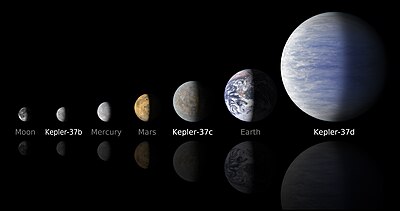List of smallest exoplanets

Below is a list of the smallest exoplanets so far discovered, in terms of physical size, ordered by radius. Some of these are unconfirmed and/or controversial.
List
The sizes are listed in units of Earth radii (R🜨). All planets listed are smaller than Earth, up to 0.7 Earth radii. The NASA Exoplanet Archive is used as the main data source.[1][2]
| Exoplanet | Radius (R🜨) | Notes and references |
|---|---|---|
| SDSS J1228+1040 b (SDSS J122859.92+104033.0 b, WD 1226+110 b) |
0.0101+0.0504 −0.0085 |
Extrasolar planetesimal. Remnant iron core.[3] |
| PSR B1828-11 b | 0.016 | Unconfirmed, controversial[1] |
| Ceres | 0.07466 | Shown for comparison |
| WD 1145+017 b | ~0.15 | Extrasolar planetesimal.[4] |
| Pluto | 0.1825 | Shown for comparison |
| Moon | 0.2739 | Shown for comparison |
| Kepler-37b | 0.296±0.037 | Smallest known exoplanet.[5] |
| Kepler-1520b | ~0.3 | Disintegrating planets with poorly known radii, all thought to be smaller than Mercury.[6][7] |
| KOI-2700b | ||
| K2-22b | ||
| PSR B1257+12 b (Draugr) | ~0.338 | Least massive known exoplanet, at 0.02 Earth masses. Radius estimated from mass-radius relationship.[8] |
| Kepler-37e | 0.37±0.18 | Dubious[9] |
| Mercury | 0.3825 | Shown for comparison |
| Kepler-444b | 0.403+0.016 −0.014 |
[10] |
| Kepler-102b | 0.47±0.02 | |
| Kepler-444c | 0.497+0.021 −0.017 |
[10] |
| Kepler-1971b (KOI-4777.01) | 0.51±0.03 | [11] |
| Kepler-1308b | 0.52+0.06 −0.05 |
|
| Kepler-138b | 0.522±0.032 | |
| Kepler-444d | 0.530+0.022 −0.019 |
[10] |
| Mars | 0.5314 | Shown for comparison |
| Kepler-62c | 0.54±0.03 | |
| Kepler-444e | 0.546+0.017 −0.015 |
[10] |
| KOI-115.03 (Kepler-105d) | 0.55+0.08 −0.07 |
Unconfirmed[12] |
| Kepler-42d | 0.57±0.18 | |
| Kepler-102c | 0.58±0.02 | |
| KOI-1843.03 | 0.59 | Unconfirmed |
| Kepler-1583b | 0.60+0.09 −0.05 |
|
| Kepler-1087b | 0.61+0.17 −0.05 |
|
| K2-89b | 0.615±0.080 | |
| Kepler-1877b | 0.624 | |
| Kepler-1371c | 0.64+0.07 −0.05 |
|
| UCF-1.02 | 0.64 | Dubious[13][14] |
| Kepler-1130d | 0.645 | |
| Kepler-1351b | 0.65+0.05 −0.04 |
|
| Kepler-1542c | 0.65+0.09 −0.06 |
|
| UCF-1.01 | 0.65 | Dubious[13][14] |
| Kepler-271d | 0.66±0.05 | |
| Kepler-431c | 0.668 | |
| Kepler-1558b | 0.68+0.06 −0.04 |
|
| K2-116b | 0.69±0.04 | |
| Kepler-141b | 0.69±0.05 | |
| K2-297b (EPIC 201497682 b) | 0.692+0.059 −0.048 |
|
| LHS 1678 b | 0.696±0.044 | |
| Kepler-1349b | 0.700+0.630 −0.110 |
|
| Kepler-378c | 0.70±0.05 | |
| K2-266c | 0.705+0.096 −0.085 |
|
| Kepler-1339b | 0.71+0.06 −0.04 |
|
| Gliese 367 b | 0.718±0.054 | Smallest known exoplanet within 10 parsecs. |
See also
References
- ^ a b Staff (10 July 2017). "Exoplanet Catalog". Extrasolar Planets Encyclopaedia. Retrieved 10 July 2017.
- ^ "Planetary Systems Composite Data". NASA Exoplanet Archive. Retrieved 12 December 2021.
- ^ "Planet SDSS J1228+1040 b". exoplanet.eu. Retrieved 2019-08-05.
- ^ Vanderburg, Andrew; John Asher Johnson; Rappaport, Saul; Bieryla, Allyson; Irwin, Jonathan; John Arban Lewis; Kipping, David; Brown, Warren R.; Dufour, Patrick; Ciardi, David R.; Angus, Ruth; Schaefer, Laura; Latham, David W.; Charbonneau, David; Beichman, Charles; Eastman, Jason; McCrady, Nate; Wittenmyer, Robert A.; Wright, Jason T. (2015). "A disintegrating minor planet transiting a white dwarf". Nature. 526 (7574): 546–549. arXiv:1510.06387. Bibcode:2015Natur.526..546V. doi:10.1038/nature15527. PMID 26490620. S2CID 4451207.
- ^ Simukoff, E.; et al. (2013). "Below One Earth Mass: The Detection, Formation, and Properties of Subterrestrial Worlds". Space Science Reviews. 180 (1–4): 71. arXiv:1308.6308. Bibcode:2013SSRv..180...71S. doi:10.1007/s11214-013-0019-1. S2CID 118597064.
- ^ Ansdell, M.; Hirano, T.; Gaidos, E. (2019). "Monitoring of the D doublet of neutral sodium during transits of two 'evaporating' planets". Monthly Notices of the Royal Astronomical Society. 485 (3): 3876–3886. arXiv:1903.06217. doi:10.1093/mnras/stz693.
[...]the radii are not known but are thought to be smaller than Mercury (0.36R⊕).
- ^ Garai, Z. (2018). "Light-curve analysis of KOI 2700b: The second extrasolar planet with a comet-like tail". Astronomy & Astrophysics. 611: A63. arXiv:1712.07461. Bibcode:2018A&A...611A..63G. doi:10.1051/0004-6361/201629676. S2CID 118885868.
We confirmed the disintegrating-planet scenario of KOI 2700b.
- ^ "Exoplanet-catalog".
- ^ Rajpaul, V. M.; Buchhave, L. A.; Lacedelli, G.; Rice, K.; Mortier, A.; Malavolta, L.; Aigrain, S.; Borsato, L.; Mayo, A. W.; Charbonneau, D.; Damasso, M.; Dumusque, X.; Ghedina, A.; Latham, D. W.; López-Morales, M.; Magazzù, A.; Micela, G.; Molinari, E.; Pepe, F.; Piotto, G.; Poretti, E.; Rowther, S.; Sozzetti, A.; Udry, S.; Watson, C. A. (2021), "A HARPS-N mass for the elusive Kepler-37d: A case study in disentangling stellar activity and planetary signals", Monthly Notices of the Royal Astronomical Society, 507 (2): 1847–1868, arXiv:2107.13900, doi:10.1093/mnras/stab2192
- ^ a b c d Campante, T.; et al. (2015). "KOI-3158: The oldest known system of terrestrial-size planets". EPJ Web of Conferences. 101: 02004. arXiv:1501.07869. Bibcode:2015EPJWC.10102004C. doi:10.1051/epjconf/201510102004. S2CID 16191462.
- ^ Cañas, Caleb I.; Mahadevan, Suvrath; Cochran, William D.; Bender, Chad F.; Feigelson, Eric D.; Harman, C. E.; Kopparapu, Ravi Kumar; Caceres, Gabriel A.; Diddams, Scott A.; Endl, Michael; Ford, Eric B.; Halverson, Samuel; Hearty, Fred; Jones, Sinclaire; Kanodia, Shubham; Lin, Andrea S. J.; Metcalf, Andrew J.; Monson, Andrew; Ninan, Joe P.; Ramsey, Lawrence W.; Robertson, Paul; Roy, Arpita; Schwab, Christian; Stefánsson, Guđmundur (2022). "A Hot Mars-sized Exoplanet Transiting an M Dwarf". The Astronomical Journal. 163 (1): 3. arXiv:2112.03958. Bibcode:2022AJ....163....3C. doi:10.3847/1538-3881/ac3088. S2CID 244954104.
{{cite journal}}: CS1 maint: unflagged free DOI (link) - ^ "Kepler-105". NASA Exoplanet Archive. Retrieved 12 December 2021.
- ^ a b Stevenson, Kevin B.; et al. (2014). "A Hubble Space Telescope Search for a Sub-Earth-sized Exoplanet in the GJ 436 System". The Astrophysical Journal. 796 (1). 32. arXiv:1410.0002. Bibcode:2014ApJ...796...32S. doi:10.1088/0004-637X/796/1/32. S2CID 118412895.
- ^ a b Lanotte, A. A.; et al. (2014). "A global analysis of Spitzer and new HARPS data confirms the loneliness and metal-richness of GJ 436 b". Astronomy and Astrophysics. 572. A73. arXiv:1409.4038. Bibcode:2014A&A...572A..73L. doi:10.1051/0004-6361/201424373. S2CID 55405647.
